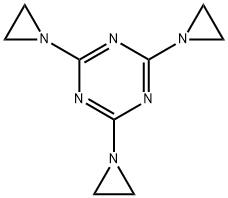TRIETHYLENEMELAMINE

- CAS No.
- 51-18-3
- Chemical Name:
- TRIETHYLENEMELAMINE
- Synonyms
- TEM;R 246;r-246;M 9500;m-9500;sk1133;nsc9706;SK 1133;NSC-9706;Tretamin
- CBNumber:
- CB6164805
- Molecular Formula:
- C9H12N6
- Molecular Weight:
- 204.23
- MOL File:
- 51-18-3.mol
- Modify Date:
- 2024/12/18 14:08:57
| Melting point | 160 °C |
|---|---|
| Boiling point | 332.73°C (rough estimate) |
| Density | 1.2815 (rough estimate) |
| refractive index | 1.7900 (estimate) |
| storage temp. | Refrigerator (+4°C) + Poison room |
| pka | 3.13±0.10(Predicted) |
| Stability | Unstable - polymerizes at room temperature. Polymerizes more readily if heated and in the presence of moisture. |
| IARC | 3 (Vol. 9, Sup 7) 1987 |
| EPA Substance Registry System | Triethylenemelamine (51-18-3) |
SAFETY
Risk and Safety Statements
| RIDADR | 3249 | |||||||||
|---|---|---|---|---|---|---|---|---|---|---|
| HazardClass | 6.1(a) | |||||||||
| PackingGroup | II | |||||||||
| Hazardous Substances Data | 51-18-3(Hazardous Substances Data) | |||||||||
| Toxicity | LD50 in mice, rats (mg/kg): 2.8, 1.0 i.p.; 15, 13 orally (Philips) | |||||||||
| NFPA 704 |
|
TRIETHYLENEMELAMINE Chemical Properties,Uses,Production
Uses
Triethylenemelamine (TEM) is a potent mutagen. It has little, if any, industrial application. TEM is mainly used in medicine as an antineoplastic agent and as a “positive control” in many in vitro and in vivo mutagenicity assays.
General Description
Odorless white crystalline powder. Melting point 160°C, then rapidly polymerizes to a white solid. Almost immediate degradation at pH 3.0; rapid degradation at pH 5.0; and very little degradation at pH 7.5.
Air & Water Reactions
Soluble in water [Hawley]. Polymerizes readily with heat or moisture.
Reactivity Profile
TRIETHYLENEMELAMINE polymerizes readily with heat or moisture. Neutralizes acids in exothermic reactions to form salts plus water. May be incompatible with isocyanates, halogenated organics, peroxides, phenols (acidic), epoxides, anhydrides, and acid halides.
Fire Hazard
Flash point data for TRIETHYLENEMELAMINE are not available; however, TRIETHYLENEMELAMINE is probably combustible.
Safety Profile
Poison by ingestion, intraperitoneal, intramuscular, intravenous, and subcutaneous routes. Experimental teratogenic and reproductive effects. Questionable carcinogen with experimental neoplastigenic and tumorigenic data. Human mutation data reported. Can cause gastrointestinal tract disturbances and bone marrow depression. When heated to decomposition it emits highly toxic fumes of NOx. Used as an antineoplastic agent and as an insect sterilant.
Carcinogenicity
In several older, limited studies, triethylenemelamine reportedly produced tumors in mice by the dermal and intraperitoneal routes and in rats by subcutaneous and/or intramuscular administration. These data were reviewed and evaluated by the IARC and judged as “limited evidence of carcinogenicity in animals.” As a result of this evaluation of the animal data and a lack of evidence of carcinogenicity in humans, the IARC placed TEM in its Group 3 category.





